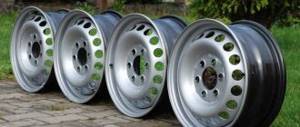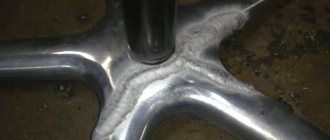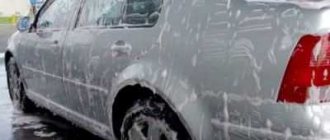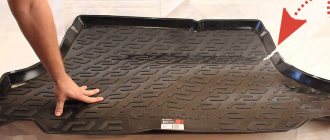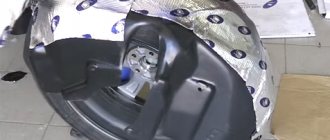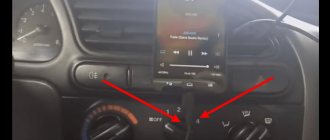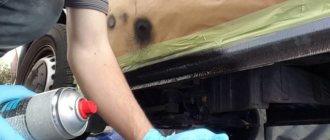In particular, the hood can be easily damaged without even applying much effort. Scratches of varying depths can occur from branches, careless movement of the car owner or unauthorized persons. What can we say about collisions that result in dents. Straightening will help straighten the hood and return it to its original appearance. Many specialized auto repair shops offer a similar service, but it is not always possible to contact specialists. At the same time, it is necessary to fix problems on the hood as quickly as possible, since in a short time it is several times more difficult to deal with. There is only one way out of this situation - to return the hood to its original appearance. This task is not easy, but with a strong desire it is quite possible to cope with it.
If you have dented the hood of your car, then there is no reason to despair, because in this article we will tell you how to fix it
Hood straightening - what can it be?
Straightening works are presented in several versions. The choice of the most appropriate one depends on the nature and extent of the damage.
- A suction cup is suitable for working with a large but shallow dent.
- If the damage is represented by a dent with metal bends and deep depressions, then it is necessary to resort to the use of a straightening hammer.
- Elimination of deep damage, which is characterized by the presence of strong stretching of the metal, will involve straightening and removing the resulting excess.
- In case of very serious damage, it makes sense to remove the damaged section of the hood and weld a new piece of metal in its place.
Straightening work can be performed using the following tool:
- A straightening hammer allows you to tap a previously removed damaged element.
- If it is not possible to dismantle the damaged area of the hood, then a special spoon is used, with the help of which the dent is squeezed out and the metal takes on a normal shape.
Almost all straightening work is carried out according to the following scheme:
- When working on a large area dent, pulling/tapping is carried out from its boundaries.
- Aligning a small dent starts from its center.
- In some cases, it makes sense to warm up the metal before starting straightening work. In this case, a blowtorch or torch will be needed. The heated surface is covered on all sides with wet rags, which creates a temperature difference. As a result of such actions, it is possible to achieve contraction of the metal.
In fact, there are a huge number of tools, methods and methods with which you can straighten the damage on the hood. You should start with your hands and only then apply more drastic methods in practice.
The body of many cars consists of such thin metal that it easily responds to manual straightening and does not require the use of additional tools. It happens that the dent itself is not serious and can easily be squeezed out with your hands, but it is difficult to get to it. In this case, you can use a heat gun, which will heat the dent from the inside. You should be careful here, since if the temperature conditions are not observed, you can observe swelling of the paintwork. The paint should not heat above 110 degrees.
When leveling out serious dents, it will not be possible to avoid damage that will have to be restored. There are such complex damages that to correct it is necessary to make holes in the hood, insert hooks into them and pull them. You can weld washers to the metal on the outside, by which the metal will be pulled or twitched. With this straightening method, each shift of the metal can be controlled, achieving high precision in the work.
It is rare that straightening does not require the application of putty. Lumps and various irregularities remain on the straightened part, which have to be painstakingly worked on. The former dent on the hood needs careful degreasing and application of automotive putty. This material quickly becomes hard, tightly adheres to the metal, can be sanded and promotes even painting. If all this work is done efficiently, then it is impossible to see the difference with the naked eye.
Now that you know how to straighten the hood, you can take further steps. First of all, you should try to bend the dent out with your hands. And only after failure you need to think about your further actions. In principle, there is nothing supernatural or impossible in removing even complex damage. No straightening master is born with his own skills, everything comes with experience. Perhaps you already have a similar talent that just needs to be revealed, and you can not only straighten your car.
Removing dents after hail
- this is a completely solvable problem for every car owner whose car has been exposed to this atmospheric phenomenon. To do this, one of four methods of paintless body repair can be used. Each of them has its own advantages and disadvantages, as well as the level of complexity of their implementation. In addition, they use different tools that should be available to craftsmen. We will discuss these repair methods in detail below.
Existing methods for removing hail dents
The procedure for removing dents without painting is fundamentally different from body repair with paint restoration. Indeed, in the case of the latter, the car body is subject to partial disassembly, which requires a significant amount of time and effort. The process of removing dents occurs directly on the body without the need to dismantle its individual parts. Currently, experts use four main methods:
- lever;
- adhesive;
- vacuum;
- thermal.
All of them belong to the so-called PDR methods, that is, paintless methods of removing dents (Paintless Dent Removal - English). Let's look at each of them separately:
- The lever method
is the most popular at service stations, as it involves the use of special levers. Carrying out repairs can sometimes be difficult because it is not possible to place the levers directly under the affected areas of the machine body. In addition, often in order to get to individual surfaces of the body, it is necessary to dismantle elements of the interior trim or technological mechanisms. - The adhesive method
is carried out using special tools that literally pull the dented surface back. To do this, special pistons are glued to the damaged area, which are subsequently pulled upward, and they, in turn, pull the surface of the body along with them. - Vacuum method
. This method is similar to the glue method. Its only difference is that instead of glued pistons, vacuum suction cups are used. - The thermal method
of removing dents after hail without painting is based on sharp heating of the damaged surface followed by rapid cooling. As a result of this approach, the body is deformed and returns to its original shape. They are usually heated with a hair dryer and cooled with compressed air.
Do not delay repairs after deformation of the surface of the case, since metal tends to remember the new shape. Therefore, the more time passes, the more difficult it will be to correct the situation. In addition, if deformed, there is a risk of damage to the paintwork. If it is not restored, there is a risk of corrosion.
Hooks for the lever method of removing dents
This method is most common at service stations. It works best on large surfaces away from ribs.
. To perform the procedure, special tools are used - long levers, with one end of which they precisely influence the dents from the inside.
If the dent has formed in a place where there is a stiffener on the inside, then there is an option when, using a construction hair dryer, the sealant on which the reinforcement is attached is heated, after which it is bent, giving access from the inside to the damaged surface. The following procedure is performed in the same way.
Often, after straightening dents, it is necessary to polish the paintwork. You can read how to do this in.
Currently, entire sets of dent removal levers are available for sale. They can include from 10 to 40 (and sometimes more) different hooks and levers, with which you can remove most dents on the surface of the car body. However, in fairness, it should be noted that a private car owner will have no use for such kits. After all, they cost a lot of money, and you will have to use them, to put it mildly, rarely. Therefore, they are more suitable for professional service stations.
However, if you still have such levers, then you can try to perform the repair procedure yourself. The process depends on the specific situation and the degree of damage, but on average the following algorithm is used:
Before performing the described procedures yourself, it will be useful for you to practice on some old body parts. The process is simple, but requires some skill.
Method for straightening dents using a ball
You can use a soccer ball with a pump. The ball must be installed so that it rests against the inner element of the panel and, when inflated, presses on the dent from the reverse side. You need to be careful not to crush the metal.
p, blockquote 21,0,0,0,0 —>
- Deflate the ball completely. You want the ball to be as flat as possible so that it can fit into the small space between the dent and the stop piece.
- Place the deflated ball on the back of the dent. The air valve must be easily accessible to connect the pump to and inflate.
- When inflating the ball, place a soft cloth over the dent. Watch the force created by the ball so as not to pump too much. Pump the ball slowly.
- When the metal returns to its original state, disconnect the pump and bleed the air.
- When pulling out a dent, you can additionally heat the front part of the panel with a hairdryer to make the metal more elastic.
p, blockquote 22,0,0,0,1 —>
It won’t take too much time to repair damage to car doors on your own. You will not need to wait a couple of days while the car is being repaired, and by repairing it yourself, you can save a decent amount of money. The desire of owners of damaged vehicles to carry out repair work without subsequent painting of the car is understandable.
Removing hail dents using glue and vacuum methods
It’s worth mentioning right away that these methods can only be used if the integrity of the paintwork is not compromised at the point of deformation
. If there are chips or scratches, then you need to get rid of them. You can read how to do this on our website. The fact is that the tools described below have a strong mechanical effect on the surface, which can cause delamination of the paintwork.
To remove hail dents with your own hands using the glue method, you need the following tools:
Dent removal kit
- minilifter (also called a reverse hammer);
- adhesive mushrooms (pistons) of various diameters;
- glue;
- hot glue gun;
- liquid for removing glue residues;
- hammer;
- Teflon core with a blunt tip.
Professional mini-lifters, designed to pull out dents up to 2 cm in diameter, are expensive. However, today there are simpler and cheaper designs on the market, which are a clamp with suction cups, which can functionally be used instead of mini-lifters. The price of such devices is much lower. An example of this would be the Dent Remover kit.
Paintless dent repair technology
One of the PDR technologies is the use of “fungi”. By gluing small suction cups with a hard center but soft edges, you can quickly pull out a dent without painting. The master will show and tell with a visual demonstration
Removing hail dents using the glue method
is performed according to the following algorithm:
- First, the body must be washed and the damaged area degreased. This can be done using various means - alcohol or white spirit ( do not use solvents for degreasing, as they can damage the paintwork
). - Glue is applied to a piston of the required diameter, and then installed in the center of the recess on the body. Leave for approximately 10 minutes to allow the glue to dry.
- After this, you need to take a mini-lifter or clamp and place the other edge of the piston in its groove. First you need to tighten the upper screw in order to prevent its free movement.
- Next, they begin to clamp the handle of the device. In this case, the surface of the damaged area of the body is smoothly leveled.
- When the work is completed, the piston comes off, and the remaining adhesive is removed using the existing liquid.
Removing dents using the glue method
As a rule, after performing the procedures described above, a bulge with a depression in the center remains. You also need to get rid of it - using a fluoroplastic or Teflon core with a blunt tip by gently tapping the edges of the bulge. After this, the bulge will disappear, and a dent of smaller diameter will appear in its place. To remove it, you need to follow the steps described in points 1-5 of the previous list, but using a piston of a smaller diameter
. In some cases, the procedure will need to be carried out three or more times in a row to completely eliminate the defect on the machine body.
Professional kits have a large number of pistons of various diameters, thanks to which craftsmen get rid of any dents. Most cheap sets are limited to two or three pistons, which do not make it possible to get rid of dents of small diameter.
Working with the vacuum method
similar in general terms to the method described above. The work sequence will be as follows:
Using a suction cup to remove dents on the body
- Wash the surface of the car body and remove all debris and small particles from the areas where the dent is located.
- Apply a vacuum suction cup to the dent you want to repair.
- Lock the suction cup in place (some models have special devices that allow you to move the suction cup along the surface of the body).
- Pump out all the air between the suction cup and the body, thus ensuring a high vacuum level.
- After fixing the suction cup in place, you need to pull it. Depending on the specific model, you can pull directly on the suction cup body, or rotate a special threaded handle.
- The suction cup will move and pull the surface of the machine body with it.
The vacuum method for removing hail dents is the most gentle on the car’s paintwork.
. Therefore, if the paintwork of your car is not of the best quality or it was applied quite a long time ago, then the vacuum method is better suited for you than others.
Method for straightening dents using a vacuum cleaner
p, blockquote 10,0,0,0,0 —>
- Turn on the vacuum cleaner and place the end of the hose over the hole on the potty, as in the illustration. You can wiggle the hose a little to let air in. This way the vacuum cleaner will suck better if it gets a little extra air.
- If you can stick your hand to the back of the dent, you can help straighten the dent by pressing on it. Thus, the impact will be on both sides.
Thermal method for removing dents after hail
The leveling process in this case involves heating the damaged area of the body to a high temperature, followed by cooling, for which special means are used. It is worth mentioning right away that exposure to high temperatures has a detrimental effect on the paintwork of the body. Therefore, after returning its geometry, it is often necessary to re-paint the treated area.
A powerful hair dryer is often used to heat the metal. And for cooling - a flow of cold air from the compressor.
When performing the procedure yourself, remember to take personal precautions and follow fire safety rules.
The thermal repair method is ineffective for very large and small but deep damage. With its help you can only get rid of medium-sized dents that have a small depth. In addition, using this method may not always lead to the desired results.
. The fact is that it all depends on the thickness and grade of the metal from which the car body is made. If it is thick enough, then even heating it to a significant temperature will not achieve a satisfactory result. Therefore, the thermal method of removing hail dents is not often used.
Results
The first thing that the owner of a car that has been damaged by hail should remember is that it is necessary to carry out repair work as quickly as possible
. Metal has a “memory”, due to which, after a long time, the deformation will take place on a permanent basis, and it will be difficult to return to its original appearance.
The most convenient ways
for removing dents with your own hands - adhesive and vacuum.
However, to perform them you need to buy the tools and materials described above. In addition, inexpensive dent removal kits have 2-3 pistons, which is sometimes not enough to repair damage with a small diameter. And the most effective method is lever
. However, we do not recommend that you do it yourself without proper skill; it is better to seek help from a service station.
If you drive carelessly, dents, scratches, chips and cracks appear on the car body. They negatively affect the appearance of the vehicle. One of the parts most susceptible to damage is the hood. In winter, icicles or snow falling from the roof may fall on it, leaving damage and dents. In summer, the body element is easily scratched by branches. Once the damage is done, the hood needs to be repaired.
When restoring a body part, the master has to deal with such problems as:
The driver can independently repair damage to the hood, which will save money and get an acceptable repair result.
Heating and subsequent cooling to straighten a dent
p, blockquote 9,0,0,0,0 —>
- Use a hair dryer on medium settings. The metal is heated with a hairdryer from 30 seconds to 1 minute, at a distance of 5–10 cm from the surface of the panel. It is necessary to constantly move the hairdryer so as not to damage the paint. Then you need to wait 5 seconds and spray the contents of the can for 10 seconds in a circular motion around the dent. The nozzle or tube should be located approximately 3 cm from the surface. When leaving the canister, the gas passes from a compressed state to an uncompressed state, this causes the temperature to drop below - 37 degrees Celsius. A thin layer of ice forms on the surface. When the ice melts, you need to wipe the surface. The method works well on slightly convex surfaces, only on metal. This won't work on a plastic bumper.
- If you use dry ice, you need to use protective gloves (preferably leather) or hold the ice through a towel.
- Dry the surface and repeat heating and cooling if necessary. Gently, not forcefully tapping your fist around the dent will help return the metal to its original state.
- Small dents respond less well to heating and cooling.
- Heating and cooling can sometimes reduce the dent, but not completely remove it.
Straightening tool
In order to straighten a dent, you will need:
- Percussion tools - metal and rubber hammers, reverse hammer.
- Anvils, dies, supports, impact pads.
- Construction hair dryer, gas torch or blowtorch. Using the equipment, the body part is heated, which subsequently helps to effectively get rid of the dent.
- Grinder, welding machine. In some cases, the damaged area is removed and a patch is welded in its place.
- Brushes of different sizes, sanding machine. After the work, it is necessary to restore the hood to its original form. To do this, the corrected area is treated with putty, sanded and a paint coating is applied to it.
Pulling out a dent with a plumber's plunger
This device can not only clear the blockage, but also pull out the dent. You should use a sink plunger, not one designed for cleaning toilets. This is a more affordable version of a special suction cup, which is used in paintless dent repair.
p, blockquote 19,0,0,0,0 —>
After pulling out the dent with a plunger, small irregularities may remain that require subsequent leveling.
It is necessary to moisten both the surface of the panel with the dent and the plunger itself, more precisely, its rubber part. You can use hot water. Hot water will make the rubber of the plunger more elastic and also warm the surface a little. You need to install the rubber valve on the dent, press and pull sharply. Smooth dents without strong creases can be pulled out in this way. There may be no trace left, or there may be a slight crease in the metal.
p, blockquote 20,0,0,0,0 —>
How to straighten or straighten a hood
In order not to overpay at a car service center, it is important to know how to straighten the hood of a car yourself. To complete this work, you will need to do the following:
- Carefully inspect the damaged area, determine the severity and nature of the damage.
- If the damage is a dent with metal bends and deep depressions, use a straightening hammer and anvil.
- Deep defects are corrected by stretching the metal and then removing excess parts.
- If the hood is severely damaged, then the worn-out piece of metal is removed and a new one is welded in its place. Subsequently, the weld is ground, the irregularities are covered with putty, primed and painted.
- In some cases, it is not possible to remove the damaged body element. In this case, use a special spoon to straighten the dent.
- Initially, general straightening is carried out: the dent is straightened. Afterwards, they begin to work out the damage in detail: level the working surface, remove minor defects.
- Large dents are repaired progressively from the edge of the damaged area to its center.
- A small defect is eliminated, on the contrary: from the center to the edges.
- To achieve tightening of the metal, cover the damaged area with a wet rag and then heat it with a blowtorch or gas torch. Next, the heated area is cooled sharply. Due to the temperature difference, the metal contracts. Wet rags are needed to protect undamaged areas of the hood from heat.
If the defect is not corrected in a timely manner, corrosion may form at the site of damage to the hood, which will subsequently affect entire parts of the body part. Therefore, you should not hesitate to carry out repair work.
After restoring the body element, the paintwork will be damaged. You should also take care to level the work area. To do this, it is primed and sanded. When a positive result is achieved, the surface is painted and an anti-corrosion coating is applied.
When straightening a body element, you should follow some recommendations:
- Minor damage should be repaired by hand, without using straightening tools. On the hood of the car, thin metal is used, after manual straightening, there will be no trace of damage, and the motorist will save time and money (there is no need to buy a spray gun, a can of paint, brushes, primer and degreaser). In addition, the use of grinding wheels and files will not be required.
- After priming and subsequent polishing, you will need to run your hand over the working surface; this step will reveal unevenness. In places where a perfectly even coating is required, use a ruler.
- It is also necessary to remember that excessive heating of the hood can negatively affect the paintwork of the part. To prevent damage to the paint, do not heat the body element to a temperature above 110 degrees Celsius.
